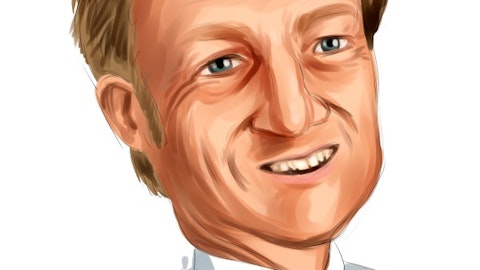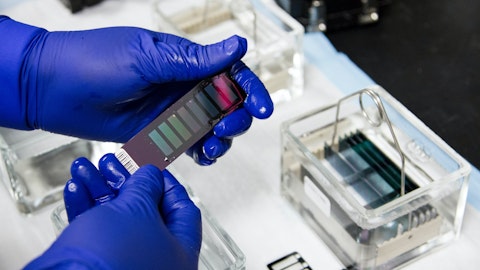Placebos track upward, ultimately plateau and then have a slow decline in drug treatment presses that curve down pretty rapidly and pretty completely. So again, it allows you to compare the AUC of drug treatment in the numerator versus AUC of placebo in the denominator. And once again, at least with 938, we put very strong numbers on the board in terms of percent inhibition. So that’s the type of data that we’ll be going for with 323. Again, we need to run the study to get the results, but it’s preclinically, it’s a very, very strong and a very potent inhibitor. And I would say we’ve even got more from an exposure standpoint, everything else, even greater pressure on the virus with 323 exposures even over 938, which were good. So again, we’ll look at the data.
It may not be possible to differentiate at that stage, but it does differentiate somehow. We certainly believe that 938 has sufficient horsepower to go the distance in most patients as a single agent, obviously we need to prove that with the Phase 2s. But to the extent we want to segment and maybe use a combo in a different patient population or relegate one of the drugs in a slightly different way than the other. Again, having both of these mechanisms at our disposal will allow us to think of all kinds of things.
Jay Olson: Great. Thank you, Jay, for the comprehensive explanation. And if I could ask just one follow-on. You have various non-virology programs at early stages, discovery stage of development. Can you just talk about what disease areas you’re interested in for those non-virology programs? Thank you.
Jay Luly: Yes, not today. As I indicated, we’ll begin to talk about that early next year.
Jay Olson: Okay, great. Look forward to that. Thanks again for taking the questions.
Jay Luly: Thank you.
Operator: Thank you. One moment, please. Our next question comes from the line of Ed Arce of H.C. Wainwright & Company. Your line is open.
Ed Arce: Hi, Jay and Paul. Thanks for taking our questions. Appreciate it. And congratulations on the initiation of the Phase 2a challenge study for 323. I also have a question in that regard, kind of drill down a little bit further from the previous question with regards to improvements measured as AUC with both virology and symptoms versus placebo. You mentioned in virology, the previous asset had — or, I guess, 938 has shown about 70% reductions in AUC. So, what I wanted to ask is, what level you believe is both competitive and clinically meaningful? Or perhaps put another way, what specific level or degree of reduction defines success for the study sufficient to proceed to further development? And then, I have a follow-up.
Jay Luly: Sure. Well, I think no one really knows yet and hopefully we’ll be the first to show is the what level you really need to drive efficacy in the real-world infection. We’ve looked at all the challenge study models that have been done. And EDP-938 is basically as good as it gets in terms of driving those kinds of numbers in a challenge model. So, we’re hopeful that those are at least adequate numbers to do that translation in the real world. And in terms of what we’re aiming for, I mean, obviously, 938 is some sort of a standard, I would aim to be in the ballpark of 938 like efficacy which, again, you can’t translate this preclinically to clinically perfectly, but I think we used the same sort of criteria metrics, thresholds to pass preclinically for 323 as we did for 938. So, we’ll see how that translates. But 938 like efficacy and the challenge is very strong. And I’m hoping we can do about that well with 323, the high bar.
Ed Arce: Right. Great. And then, staying with 323, I wanted to ask also, given that you’re testing two different doses, one with a loading dose in the first day and another one which is uniform throughout the treatment. If both of those show positive encouraging results, what would be the rationale to continue to study both doses, especially given the differential populations that might ultimately be treated with 323?
Jay Luly: Yes. It’s a good question, Ed. I think probably the short answer is we’re hoping that we will define a dose from the challenge study and then move on forward. Obviously, 600 and QD for five days has more sort of horsepower, maybe more than we need, right? And so infectious disease often will use a loading dose to help you get to steady state quicker and then steady-state PK. And then — so what we’re asking really is can that lower dose on the tail end of the — well not the tail end, but after the high loading dose and the maintenance dose — lower maintenance dose, is that enough, just as good horsepower. Obviously, from a cost of goods perspective, they’re very different. And we — so we — it’s worth exploring, and we’ll get an answer, and hopefully, we’ll get a clear answer in terms of helping us guide future studies.
Ed Arce: Okay. Great. And actually, one last one, if I may. Also, as has been asked before on the non-virology indications. I recognize that you’re not prepared at this moment to discuss specifics. But just in terms of timing, early 2024, would that necessarily be around JPM? And also, given your expertise with these new candidates necessarily be small molecule assets? Thanks so much.
Jay Luly: Well, we — you’re correct. Our historic skill set has been in small molecule drug discovery and development. That is still predominantly our main focus. And with regards to timing, it will be early next year.
Ed Arce: Great. Thank you so much.
Jay Luly: You’re welcome.
Operator: Thank you. One moment, please. Our next question comes from the line of Eric Joseph of JPMorgan. Your line is open.




